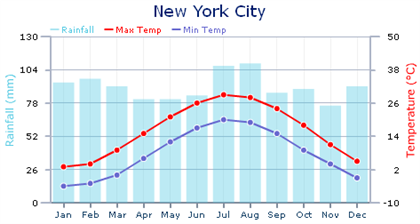Weather and Climate:
New York City itself experiences a humid subtropical, continental climate and New York is thus the northernmost major city on the North American continent with this categorization. The suburbs to the immediate north and west lie in the transition zone from a humid subtropical to a humid continental climate. Winters are cold and damp, and prevailing wind patterns that blow offshore minimize the moderating effects of the Atlantic Ocean. Spring and autumn are unpredictable and can range from chilly to warm, although they are usually mild with low humidity. Summers are typically warm to hot and humid.



Winter temperatures average below freezing during January and February while summers prevail with warmth from June to August. Much precipitation occurs from fall through spring but is quite consistent throughout the year.





Winter temperatures average below freezing during January and February while summers prevail with warmth from June to August. Much precipitation occurs from fall through spring but is quite consistent throughout the year.


Region of New England Upland:
Most of New York City belongs to the New England Upland region of the many regions in New York. The New England Upland is mostly made of hills and low mountains. The southern part of the Hudson River Valley along with the Taconic mountains are located in this region. Other attractions that are included in this region are Mohawk river, West Point army, Madison Square Garden, the Museum of Natural History and Yonkers city. One of the biggest allurements of the New England Upland is the Hudson River. The region also has very good soil.
http://www2.lhric.org/pocantico/newyork/regions.htm
http://www2.lhric.org/pocantico/newyork/newenglandupland.htm